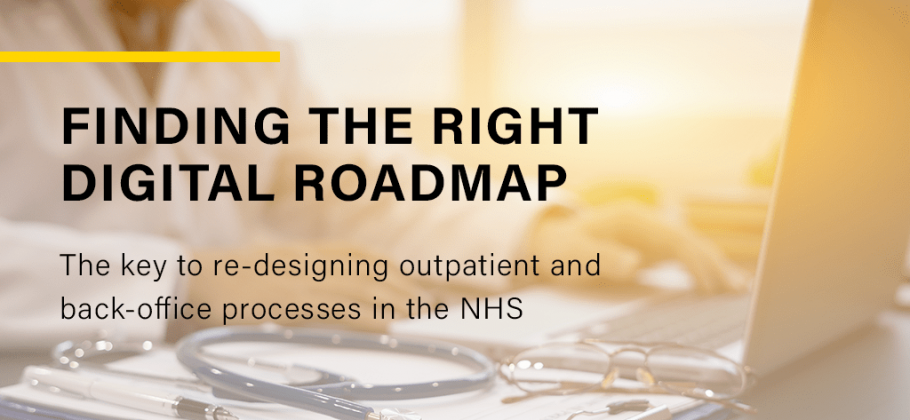The key to re-designing outpatient and back-office processes in the NHS
Ryan Reed, Head of Public Sector Sales
NHS Trusts gathered at a discussion group led by SPS to discuss the challenges of digitisation, and the need for more guidance surrounding digital transformation.
NHS Trusts and organisations are facing significant challenges with digitisation. The benefits of improved operational and back office efficiency, and — ultimately — enhanced patient experience, are clear. However, significant hurdles must be overcome, and new ways of working need to be developed, in order to reap the full benefits of digitisation. Funding and technology are not enough — Trusts need guidance, management, and communication to share best practice in order to successfully go digital.
Digitisation cannot be a one-size-fits-all solution. Different Trusts, and even different hospitals within the same Trust, are all at varying stages of maturity, and have their own individual processes, workflows, and budgets. The challenge is not simply digitising these processes, but finding a digital roadmap that reconciles these differences. Unified leadership needs to be provided for budgets and funding if tangible results are to be expected.
With £200M of funding recently released to help advance Trusts to GDE (Global Digital Exemplar) status, sharing GDE innovation blueprints and strategies can only achieve so much. These blueprints are often specific to the digital products in use, and the outcome-based strategies makes them unique to the 17 GDEs rather than universal to the remaining 157, meaning their guidance is limited.
Furthermore, this funding can only drive limited change without the appropriate steerage in place. Unified leadership needs to be provided for budgets and funding if tangible results are to be expected, with Trusts in some cases needing to manage innovation across over 200 separate entities. Funding needs to be provided for management and roadmaps, as well as actual transformation, allowing the NHS’ budget to be used more efficiently and effectively, without compromising any areas. If the main aim of digitisation is to unify organisations and information, then communication is key to achieving this.
The importance of communication is evident in digital platforms themselves. A key issue for Trusts when choosing a digital provider, is ensuring that they do not become tied down by specific systems or Emerging Architecture that cannot communicate or integrate with other systems, resulting in an ecosystem vendor lock-in.
Larger NHS organisations need solutions that act as ‘building blocks’ that can fit together without acting as a limiting one-size-fits all. For example, standards worked up between industry bodies such as TechUK, INTEROpen and the NHS should allow systems to interoperate through open standards and APIs; however there is evidence that vendors are gaming these principles by creating proprietary APIs that require a commercial partnership to access data. This has the potential to create barriers rather than opening up systems. Vendors have significant commercial investment in their intellectual property and are unlikely to want smaller software vendors picking off features and functionality.
Ultimately, the key objective of digitisation is to improve the user experience, both patient and clinician. Digital innovation has the potential to unlock fast, remote access to information, and more collaborative ways of working, all of which are key to enhancing patients’ experience. Kent Local Authority has seen this first hand: their shift to the Cloud has revolutionised their back-office processes, such that the snow storms at the beginning of the year had little effect on those services. They have also been able to significantly reduce their estates footprint as staff work flexibly and remotely rather than needing to be in-house to access information.
This being said, it has been a long and difficult journey to transfer all processes and services. Whilst there are many suppliers who can provide technology for digital innovation, the key issue is change management: the re-design of processes, the training of staff and actively implementing these processes into existing organisations. Technology is only the first step in digital innovation; transforming the people and processes associated with this technology is where the true challenge lies.
If back office processes could be digitised, it could be the first step in more patient facing areas of the NHS. Remote access to information could in turn support initiatives such as virtual clinics using video consultations, for follow-ups or less urgent appointments. This will be essential for organisations’ financial sustainability when tariff changes kick in next year. With 127 million appointments in the UK last year, and doctors believing that 10–20% of these could have been avoided, digital back office processes are a crucial first step in advancing patient facing engagement.
Digital innovation relies on people and communication within the NHS, just as much as it can enhance communication and improve the experience of patients and carers alike. The NHS needs a transformation partner who will focus not only on a digital solution, but on how this can be tailored to each individual organisation to suit and benefit the most people, from patients, carers, admin, and across the organisation as a whole
Join the SPS Circle of Trusts Community.
Click here to apply.











